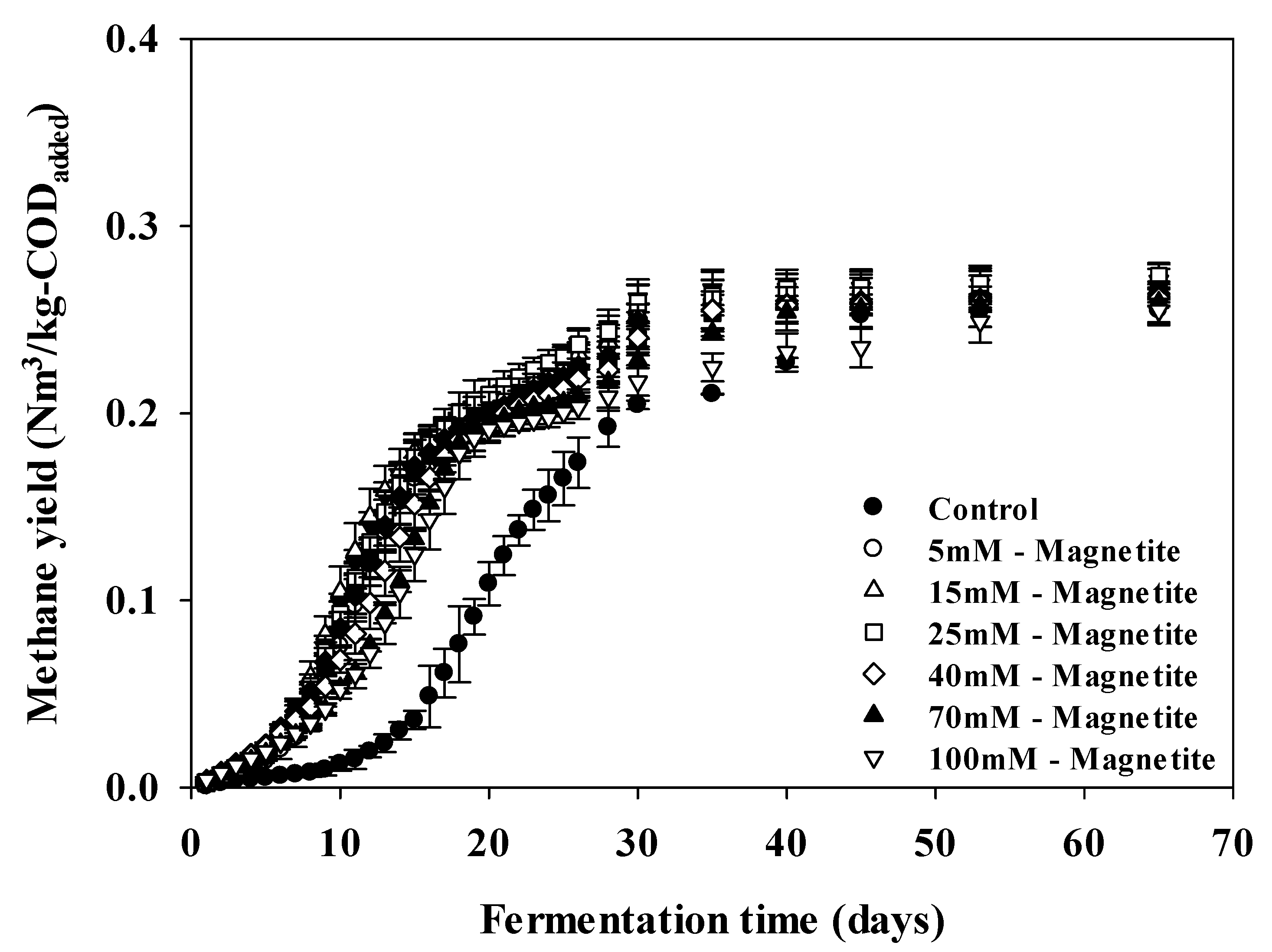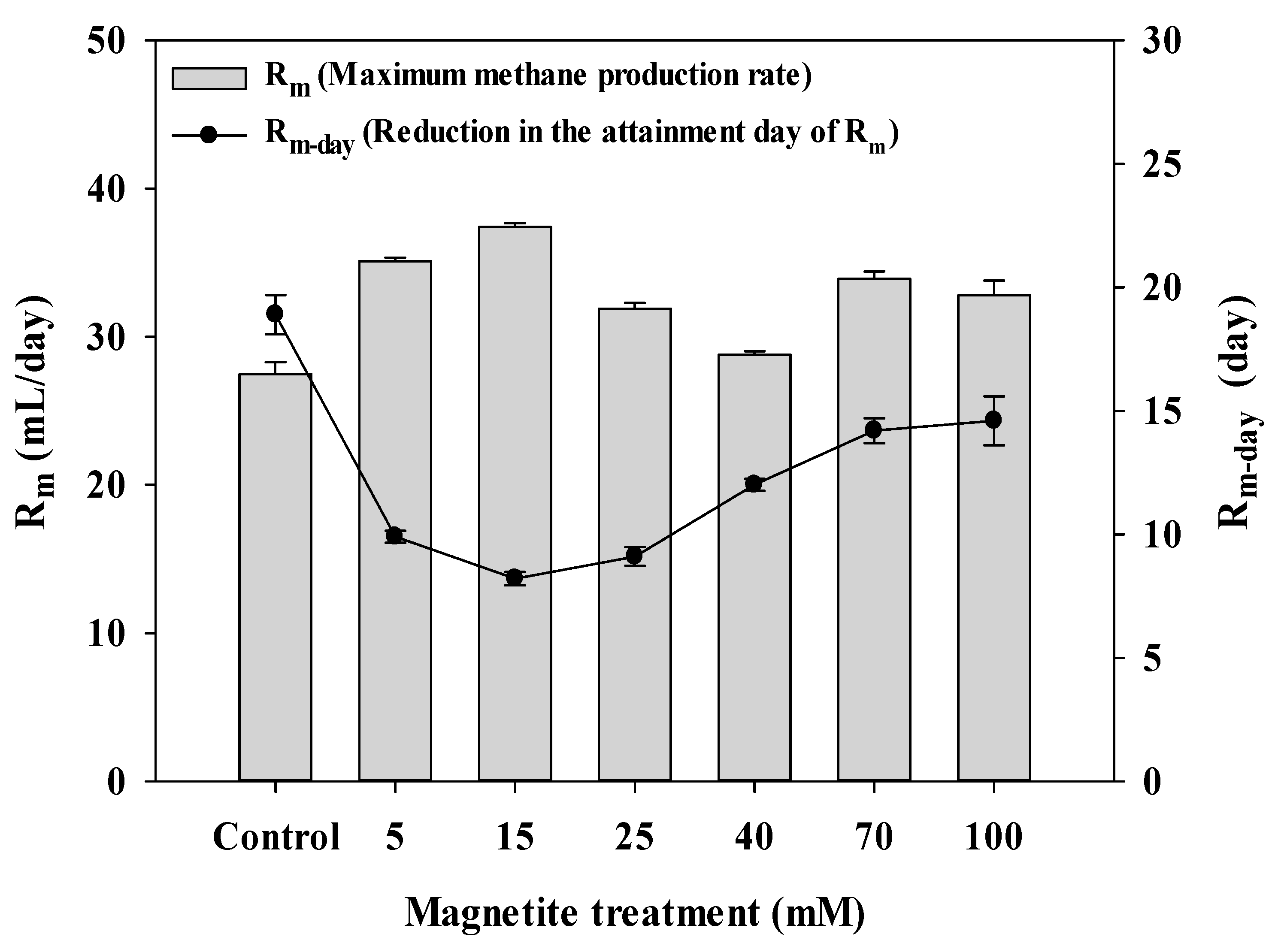Residence Time Reduction in Anaerobic Reactors: Investigating the Economic Benefits of Magnetite-Induced Direct Interspecies Electron Transfer Mechanism
Abstract
1. Introduction
2. Materials and Methods
2.1. Materials
2.2. Biochemical Methane Potential (BMP) Assay
2.3. Analysis of Reaction Kinetics
2.4. Chemical Analysis
2.5. Statistical Analysis
3. Results and Discussion
3.1. Biochemical Methane Potential Assay
3.2. Reaction Kinetics of Methane Production
4. Conclusions
Author Contributions
Funding
Data Availability Statement
Conflicts of Interest
References
- MOTIE [Ministry of Trade Industry and Energy]. New & Renewable Energy White Paper; MOTIE [Ministry of Trade Industry and Energy]: Sejong, Republic of Korea, 2020.
- ME [Ministry of Environment]. Status of Installation and Operation of Food Waste Treatment Facilities in 2020; ME [Ministry of Environment]: Sejong, Republic of Korea, 2021.
- ME [Ministry of Environment]. Status of Organic Waste Biogasification Facilities in 2021; ME [Ministry of Environment]: Sejong, Republic of Korea, 2021.
- KEITI [Korea Environmental Industry & Technology Institute]. Trends in Land Treatment of Food Wastewater; KEITI [Korea Environmental Industry & Technology Institute]: Seoul, Republic of Korea, 2016.
- Meegoda, J.N.; Li, B.; Patel, K.; Wang, L.B. A review of the processes, parameters, and optimization of anaerobic digestion. Int. J. Environ. Res. Public Health 2018, 15, 2224. [Google Scholar] [CrossRef]
- Yadav, M.; Joshi, C.; Paritosh, K.; Thakur, J.; Pareek, N.; Masakapalli, S.K.; Vivekanand, V. Organic waste conversion through anaerobic digestion: A critical insight into the metabolic pathways and microbial interactions. Metab. Eng. 2022, 69, 323–337. [Google Scholar] [CrossRef] [PubMed]
- Baek, G.; Kim, J.; Lee, C. A review of the effects of iron compounds on methanogenesis in anaerobic environments. Renew. Sustain. Energy Rev. 2019, 113, 109282. [Google Scholar] [CrossRef]
- Yeo, J.; Kim, C.-G.; Lee, J.-H.; Song, E.; Yoon, Y.-M. Effects of Water Potential on Anaerobic Methane Production and a Microbial Consortium. Fermentation 2023, 9, 244. [Google Scholar] [CrossRef]
- El-Qelish, M.; Elgarahy, A.M.; Ibrahim, H.S.; El-Kholly, H.K.; Gad, M.; Ali, M.E.M. Multi-functional core-shell pomegranate peel amended alginate beads for phenol decontamination and bio-hydrogen production: Synthesis, characterization, and kinetics investigation. Biochem. Eng. J. 2023, 195, 108932. [Google Scholar] [CrossRef]
- Akindele, A.A.; Sartaj, M. The toxicity effects of ammonia on anaerobic digestion of organic fraction of municipal solid waste. Waste Manag. 2018, 71, 757–766. [Google Scholar] [CrossRef] [PubMed]
- Li, L.; Xu, Y.; Dai, X.; Dai, L. Principles and advancements in improving anaerobic digestion of organic waste via direct interspecies electron transfer. Renew. Sustain. Energy Rev. 2021, 148, 111367. [Google Scholar] [CrossRef]
- Müller, N.; Worm, P.; Schink, B.; Stams, A.J.; Plugge, C.M. Syntrophic butyrate and propionate oxidation processes: From genomes to reaction mechanisms. Environ. Microbiol. Rep. 2010, 2, 489–499. [Google Scholar] [CrossRef]
- Morita, M.; Malvankar, N.S.; Franks, A.E.; Summers, Z.M.; Giloteaux, L.; Rotaru, A.E.; Rotaru, C.; Lovley, D.R. Potential for direct interspecies electron transfer in methanogenic wastewater digester aggregates. MBio 2011, 2, e00159-11. [Google Scholar] [CrossRef]
- Rotaru, A.-E.; Shrestha, P.M.; Liu, F.; Markovaite, B.; Chen, S.; Nevin, K.P.; Lovley, D.R. Direct interspecies electron transfer between Geobacter metallireducens and Methanosarcina barkeri. Appl. Environ. Microbiol. 2014, 80, 4599–4605. [Google Scholar] [CrossRef]
- Baek, G.; Kim, J.; Kim, J.; Lee, C. Role and potential of direct interspecies electron transfer in anaerobic digestion. Energies 2018, 11, 107. [Google Scholar] [CrossRef]
- Kim, S.-Y.; Bae, G.-S.; Lee, J.-H.; Yoon, Y.-M.; Kim, C.-H. Effects of Magnetite (Fe3O4) as an Electrical Conductor of Direct Interspecies Electron Transfer on Methane Production from Food Wastewater in a Plug Flow Reactor. Processes 2023, 11, 3001. [Google Scholar] [CrossRef]
- Tan, J.; Wang, J.; Xue, J.; Liu, S.-Y.; Peng, S.-C.; Ma, D.; Chen, T.-H.; Yue, Z. Methane production and microbial community analysis in the goethite facilitated anaerobic reactors using algal biomass. Fuel 2015, 145, 196–201. [Google Scholar] [CrossRef]
- Wang, G.; Li, Q.; Gao, X.; Wang, X.C. Synergetic promotion of syntrophic methane production from anaerobic digestion of complex organic wastes by biochar: Performance and associated mechanisms. Bioresour. Technol. 2018, 250, 812–820. [Google Scholar] [CrossRef]
- Chen, Q.; Liu, C.; Liu, X.; Sun, D.; Li, P.; Qiu, B.; Dang, Y.; Karpinski, N.A.; Smith, J.A.; Holmes, D.E. Magnetite enhances anaerobic digestion of high salinity organic wastewater. Environ. Res. 2020, 189, 109884. [Google Scholar] [CrossRef]
- Hwang, Y.; Kim, D.; Shin, H.-S. Inhibition of nitrate reduction by NaCl adsorption on a nano-zero-valent iron surface during a concentrate treatment for water reuse. Environ. Technol. 2015, 36, 1178–1187. [Google Scholar] [CrossRef] [PubMed]
- Sebastian, A.; Nangia, A.; Prasad, M. Cadmium and sodium adsorption properties of magnetite nanoparticles synthesized from Hevea brasiliensis Muell. Arg. bark: Relevance in amelioration of metal stress in rice. J. Hazard. Mater. 2019, 371, 261–272. [Google Scholar] [CrossRef]
- Aguilar-Moreno, G.S.; Navarro-Cerón, E.; Velázquez-Hernández, A.; Hernández-Eugenio, G.; Aguilar-Méndez, M.Á.; Espinosa-Solares, T. Enhancing methane yield of chicken litter in anaerobic digestion using magnetite nanoparticles. Renew. Energy 2020, 147, 204–213. [Google Scholar] [CrossRef]
- Altamirano-Corona, M.F.; Anaya-Reza, O.; Durán-Moreno, A. Biostimulation of food waste anaerobic digestion supplemented with granular activated carbon, biochar and magnetite: A comparative analysis. Biomass Bioenergy 2021, 149, 106105. [Google Scholar] [CrossRef]
- Li, D.; Song, L.; Fang, H.; Li, P.; Teng, Y.; Li, Y.-Y.; Liu, R.; Niu, Q. Accelerated bio-methane production rate in thermophilic digestion of cardboard with appropriate biochar: Dose-response kinetic assays, hybrid synergistic mechanism, and microbial networks analysis. Bioresour. Technol. 2019, 290, 121782. [Google Scholar] [CrossRef]
- Yan, W.; Zhang, L.; Wijaya, S.M.; Zhou, Y. Unveiling the role of activated carbon on hydrolysis process in anaerobic digestion. Bioresour. Technol. 2020, 296, 122366. [Google Scholar] [CrossRef]
- Park, J.-H.; Kang, H.-J.; Park, K.-H.; Park, H.-D. Direct interspecies electron transfer via conductive materials: A perspective for anaerobic digestion applications. Bioresour. Technol. 2018, 254, 300–311. [Google Scholar] [CrossRef]
- Oh, S.-Y.; Yoon, Y.-M. Energy recovery efficiency of poultry slaughterhouse sludge cake by hydrothermal carbonization. Energies 2017, 10, 1876. [Google Scholar] [CrossRef]
- Lee, J.-H.K.; Kim, T.-B.; Kim, C.-H.; Yoon, Y.-M. Effects of Magnetite(Fe3O4) as Electrical Conductor of Direct Interspecies Electron Transfer on Methane Yield of Food Wastewater. J. Korea Org. Resour. Recycl. Assoc. 2023, 31, 15–26. [Google Scholar] [CrossRef]
- APHA. Standard Methods for the Examination of Water and Wastewater; Water Environment Federation: Alexandria, VA, USA, 1998; p. 324. [Google Scholar]
- Sørensen, A.H.; Winther-Nielsen, M.; Ahring, B.K. Kinetics of lactate, acetate and propionate in unadapted and lactate-adapted thermophilic, anaerobic sewage sludge: The influence of sludge adaptation for start-up of thermophilic UASB-reactors. Appl. Microbiol. Biotechnol. 1991, 34, 823–827. [Google Scholar] [CrossRef]
- Duncan, D.B. Multiple range and multiple F tests. Biometrics 1955, 11, 1–42. [Google Scholar] [CrossRef]
- Lee, J.-H.; Lee, J.-H.; Kim, S.-Y.; Yoon, Y.-M. Effect of Addition of Zero-Valent Iron (Fe) and Magnetite (Fe3O4) on Methane Yield and Microbial Consortium in Anaerobic Digestion of Food Wastewater. Processes 2023, 11, 759. [Google Scholar] [CrossRef]
- Zhang, J.; Lu, T.; Wang, Z.; Wang, Y.; Zhong, H.; Shen, P.; Wei, Y. Effects of magnetite on anaerobic digestion of swine manure: Attention to methane production and fate of antibiotic resistance genes. Bioresour. Technol. 2019, 291, 121847. [Google Scholar] [CrossRef]
- Wang, T.; Zhang, D.; Dai, L.; Dong, B.; Dai, X. Magnetite triggering enhanced direct interspecies electron transfer: A scavenger for the blockage of electron transfer in anaerobic digestion of high-solids sewage sludge. Environ. Sci. Technol. 2018, 52, 7160–7169. [Google Scholar] [CrossRef]
- Akturk, A.S.; Demirer, G.N. Improved food waste stabilization and valorization by anaerobic digestion through supplementation of conductive materials and trace elements. Sustainability 2020, 12, 5222. [Google Scholar] [CrossRef]
- Zhang, J.; Wang, Z.; Lu, T.; Liu, J.; Wang, Y.; Shen, P.; Wei, Y. Response and mechanisms of the performance and fate of antibiotic resistance genes to nano-magnetite during anaerobic digestion of swine manure. J. Hazard. Mater. 2019, 366, 192–201. [Google Scholar] [CrossRef] [PubMed]
- Lee, J.; Koo, T.; Yulisa, A.; Hwang, S. Magnetite as an enhancer in methanogenic degradation of volatile fatty acids under ammonia-stressed condition. J. Environ. Manag. 2019, 241, 418–426. [Google Scholar] [CrossRef] [PubMed]
- Yamada, C.; Kato, S.; Ueno, Y.; Ishii, M.; Igarashi, Y. Conductive iron oxides accelerate thermophilic methanogenesis from acetate and propionate. J. Biosci. Bioeng. 2015, 119, 678–682. [Google Scholar] [CrossRef] [PubMed]
- Mostafa, A.; Im, S.; Song, Y.-C.; Ahn, Y.; Kim, D.-H. Enhanced anaerobic digestion by stimulating DIET reaction. Processes 2020, 8, 424. [Google Scholar] [CrossRef]
- Zhang, Y.; Li, J.; Liu, F.; Yan, H.; Li, J.; Zhang, X. Reduction of Gibbs free energy and enhancement of Methanosaeta by bicarbonate to promote anaerobic syntrophic butyrate oxidation. Bioresour. Technol. 2018, 267, 209–217. [Google Scholar] [CrossRef]
- Jing, Y.; Wan, J.; Angelidaki, I.; Zhang, S.; Luo, G. iTRAQ quantitative proteomic analysis reveals the pathways for methanation of propionate facilitated by magnetite. Water Res. 2017, 108, 212–221. [Google Scholar] [CrossRef]






| Parameters | pH | TS 1 | VS 2 | TKN 3 | NH4+-N 4 | TCOD 5 | SCOD 6 | Alkalinity (as CaCO3) | TVFAs 7 (as Acetate) |
|---|---|---|---|---|---|---|---|---|---|
| (-) | (mg/L) | ||||||||
| Food wastewater | 3.73 | 112,467 | 99,311 | 4393 | 613 | 179,540 | 153,127 | n.a. 8 | 11,513 |
| Inoculum | 7.93 | 45,333 | 24,567 | 5018 | 3763 | 29,727 | 9727 | 29,208 | 407 |
| Parameter | Residence Time (Days) | Control | Magnetite Concentration (mM-Fe3O4) | |||||
|---|---|---|---|---|---|---|---|---|
| 5 | 15 | 25 | 40 | 70 | 100 | |||
| Methane potential (Nm3/kg-CODadded) | 15 | 0.036 e 2 | 0.165 ab | 0.180 a | 0.176 a | 0.151 bc | 0.133 cd | 0.124 d |
| 20 | 0.109 c | 0.197 ab | 0.206 ab | 0.210 a | 0.195 ab | 0.195 ab | 0.191 b | |
| 30 | 0.205 e | 0.253 ab | 0.253 ab | 0.259 a | 0.240 bc | 0.228 cd | 0.217 de | |
| 40 | 0.227 b | 0.259 a | 0.264 a | 0.267 a | 0.258 a | 0.254 a | 0.233 b | |
| 65 1 | 0.255 b | 0.264 ab | 0.272 a | 0.273 a | 0.262 ab | 0.259 ab | 0.255 b | |
Disclaimer/Publisher’s Note: The statements, opinions and data contained in all publications are solely those of the individual author(s) and contributor(s) and not of MDPI and/or the editor(s). MDPI and/or the editor(s) disclaim responsibility for any injury to people or property resulting from any ideas, methods, instructions or products referred to in the content. |
© 2024 by the authors. Licensee MDPI, Basel, Switzerland. This article is an open access article distributed under the terms and conditions of the Creative Commons Attribution (CC BY) license (https://creativecommons.org/licenses/by/4.0/).
Share and Cite
Kim, T.-B.; Lee, J.-H.; Yoon, Y.-M. Residence Time Reduction in Anaerobic Reactors: Investigating the Economic Benefits of Magnetite-Induced Direct Interspecies Electron Transfer Mechanism. Energies 2024, 17, 358. https://doi.org/10.3390/en17020358
Kim T-B, Lee J-H, Yoon Y-M. Residence Time Reduction in Anaerobic Reactors: Investigating the Economic Benefits of Magnetite-Induced Direct Interspecies Electron Transfer Mechanism. Energies. 2024; 17(2):358. https://doi.org/10.3390/en17020358
Chicago/Turabian StyleKim, Tae-Bong, Jun-Hyeong Lee, and Young-Man Yoon. 2024. "Residence Time Reduction in Anaerobic Reactors: Investigating the Economic Benefits of Magnetite-Induced Direct Interspecies Electron Transfer Mechanism" Energies 17, no. 2: 358. https://doi.org/10.3390/en17020358
APA StyleKim, T.-B., Lee, J.-H., & Yoon, Y.-M. (2024). Residence Time Reduction in Anaerobic Reactors: Investigating the Economic Benefits of Magnetite-Induced Direct Interspecies Electron Transfer Mechanism. Energies, 17(2), 358. https://doi.org/10.3390/en17020358







